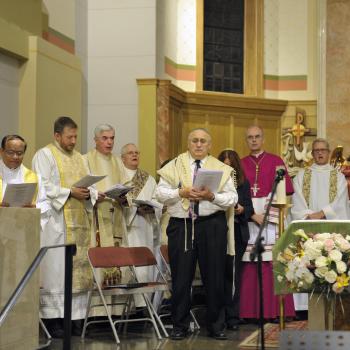It can be tempting, when ingesting a daily diet of internet chatter, to think the Catholic Church these days is a disaster. Things have never been worse. Vatican II destroyed the faith. Batten down the hatches. The barque of Peter is taking on water, and sinking fast.
So goes the popular thinking among some on the web. Clearly, the institution’s days are numbered.
Really?
This morning, I read about a new church being built in the heart of the South, an area once dominated by Protestants. It is, in fact, a new cathedral, rising in Raleigh, North Carolina:
Bishop Michael Burbidge announced the construction of Holy Name of Jesus Cathedral at a press conference in May.
Noting the rapid growth of the diocese, the bishop said it is his “hope, dream and prayer to build a mother church, to build a cathedral” to replace the existing Sacred Heart Cathedral in downtown Raleigh.
Sacred Heart Cathedral has a capacity of 320 people and was originally completed in 1924, when the Catholic population of the state was just 6,000. Today, however, the cathedral has burst its seams, serving a parish base of 3,000 Catholics in a diocese that is home to almost half a million Catholics, or 4.8% of the state’s population.
“We have people literally out in the street,” the bishop said, pointing out that Christmas and Easter celebrations see typically 13-14 Masses, with overflow locations at the cathedral-school basement and local Clarion hotel unable to serve the influx of worshippers.
Bishop Burbidge told reporters that the cathedral helps the bishop “gather the faithful of the diocese to worship as one.”
“Our current cathedral does not [allow that], because it is the smallest one in the U.S., except for Juneau, Alaska.”
Bishop Burbidge explained the diocese has seen 180% growth since 1990. By 2030, the diocese is expected to serve more than 1 million Catholics. “We are a vibrant diocese,” he said.
The bishop added that 1,200 people came into the Church at this year’s Easter vigil, he is celebrating the confirmation of 3,500 high-schoolers in 2014, and he just dedicated his 11th new church in his eight years as bishop.
This sent me on a search for more information about the state of the Catholic Church—and I found it, on a site called Catholic Voices. This posting from March of 2013 didn’t get much attention last year, maybe because it is a site based in the UK. But it’s a treasure trove of facts and statistics. If you want a clear and unbiased picture of the state of global Catholicism these days, here:
Viewed globally the Church experienced a spectacular growth over the twentieth century which shows little sign of slowing.
In 1900 there were roughly 266 million Catholics in the world. This rose to 1,045 million by 2000. By 2010 there were 1,197 million [just over a billion], according to the 2012 edition of the Annuarium Statisticum Ecclesiae, the ‘Statistical Yearbook of the Church’. Over the last 40 years, Catholics have consistently made up between 17 and 18pc of the world’s population; having been steadily about 17.3pc in recent years, they now are probably about 17.5pc. Current growth in the world’s Catholic population is slightly outpacing general population growth.
Peter Seewald was right to say to Pope Benedict, when interviewing him for 2010’s Light of the World, that: “Never before has the Catholic Church had more believers, never before such extension, literally to the ends of the earth.”
…Over the course of the twentieth century, the population of Latin America and the Caribbean rose from about 60 million to 561 million, while the number of Catholics there rose from 53 million to about 449 million.
Pentecostalism has made strong inroads, partly a consequence of the low numbers of priests to population (one priest per 8,000 Catholics). But seminary enrollment is on the rise, according to John Allen’s Future Church, increasing 440 per cent between 1984 and 2009. (The number of seminarians in Bolivia, for example, rose from 49 to 714 between 1972 and 2001, while the number in Honduras rose from 40 to 170 between 1989 and 2007.)
Catholicism has grown more dramatically in Africa than anywhere else in the world over the last century. In 1900, there were fewer than two million Catholics in sub-Saharan Africa, whereas by 2000, there were more than 130 million; this, as John Allen points out in The Future Church, represents a staggering growth rate of more than 6,000 per cent. Current estimates reckon that there are about 160 million Catholics in Africa, though even these estimates may be too low; the Church in Africa lacks the institutional framework to track growth accurately, and if the Gallup World Poll can be trusted, there may already be almost 200 million Africans claiming to be Catholic. Either way, growth in Africa’s Catholic population is far higher than among the general population.
This spectacular growth is a truly indigenous phenomenon. The number of Western missionaries active in Africa has been declining since the mid-1960s, while the African Church has produced vast numbers of priests. Interviewed by John Allen in 2005, the then Archbishop on Nairobi said that among his biggest problems was an excess of vocations, such that “seminaries built for one hundred now have almost two hundred.” In Nigeria, where there are about 20 million Catholics, one seminary alone has more than a thousand students. This may be the biggest seminary in the world, but even then the Nigerian Church is overstretched, as, in Allen’s words, “Africans are being baptized even more rapidly than they’re being ordained.”
If Africa ended 2010 with 765 more clergy than in 2009, Asia did even better; the latest edition of Annuarium Statisticum Ecclesiae records that Asia was the continent which saw the most growth in priest and deacon numbers during that period, resulting in 1,695 more clergy in Asia in 2010 than in 2009. In Asia overall, the proportion of Catholics more than doubled over the course of the twentieth century (just 1.2 per cent of Asians were Catholic in 1900, but three per cent of Asians were in 2000). This growth has taken place not only in traditional Catholic countries such as the Philippines — the third largest Catholic country in the world, where there were more Catholic baptisms in 2000 than in France, Spain, Italy, and Poland combined — but in mission countries such as South Korea, where the number of Catholics doubled to more than five million people between 1985 and 2005; as well as India, whose Catholic population rose from two million to more than 17 million over the course of the twentieth century.
I could go on. But you get the idea. Check out the Catholic Voices site for a fuller picture—which includes the genuinely impressive recovery of vocations in Europe and North America. Truth be told, the numbers in parts of the United States—like Raleigh, for example—are historic. (I was thunderstruck by a visit I made to a parish in Dallas last year; the place is so busy and bustling, one woman told me, some nights you can’t find a parking space in the church lot.)
And converts, of course, keep coming; the Archdiocese of Washington just logged a record number of new Catholics who joined the faith through RCIA.
I found all of this inspiring—putting a lie to what the Catholic Voices site aptly calls “the myth of Catholic ‘decline.'”
Be of good cheer. This is not the story of a faith nearing the end of the road.
In many places, in fact, the journey is just beginning.
UPDATE: Some encouraging news out of Spain these days, too.
















